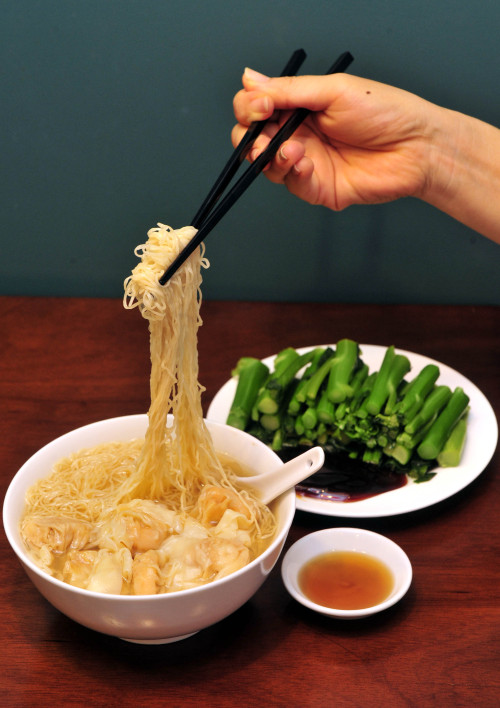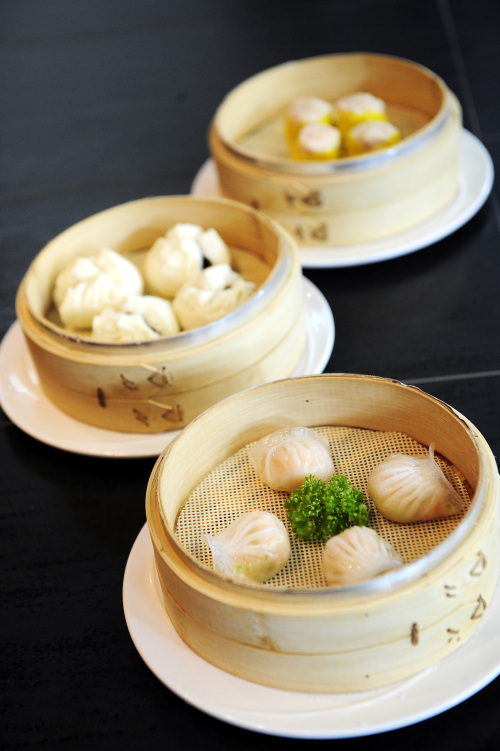Wonton noodle soup and handmade dim sum do not disappoint
One of the major delights of taking a trip to Hong Kong is the food.
Just one three-to-four hour flight lands you in a place populated with spongy dragon fruit, sweet sugarcane juice and endless trolleys full of the most delectable dim sum.
Of course, there are also the wonderful little shops where one can dip into bowls of congee and wonton noodle soup or slurp away at sweet tofu and tapioca-heavy desserts.
Considering the region’s proximity to Korea, more authentic Hong Kong eats have been a long time coming in making headway here.
Two new spots do not disappoint and promise to set the stage for more.
Cheung Kee
Wonton noodles, afloat in a golden broth, make for great comfort food.
Something about the small, purse-like dumplings, which have soaked up the soup so it floods the mouth after you pop one in, and those springy, thin noodles, satisfy and soothe.
Perhaps it was that which prompted Jae Kim, 41, to approach the owner of a famous Hong Kong wonton noodle restaurant and ask if he could bring it to Korea.
One of the major delights of taking a trip to Hong Kong is the food.
Just one three-to-four hour flight lands you in a place populated with spongy dragon fruit, sweet sugarcane juice and endless trolleys full of the most delectable dim sum.
Of course, there are also the wonderful little shops where one can dip into bowls of congee and wonton noodle soup or slurp away at sweet tofu and tapioca-heavy desserts.
Considering the region’s proximity to Korea, more authentic Hong Kong eats have been a long time coming in making headway here.
Two new spots do not disappoint and promise to set the stage for more.
Cheung Kee
Wonton noodles, afloat in a golden broth, make for great comfort food.
Something about the small, purse-like dumplings, which have soaked up the soup so it floods the mouth after you pop one in, and those springy, thin noodles, satisfy and soothe.
Perhaps it was that which prompted Jae Kim, 41, to approach the owner of a famous Hong Kong wonton noodle restaurant and ask if he could bring it to Korea.

After meeting Kim, the owner agreed and Cheung Kee opened in Hongdae this March.
Fresh noodles, wonton skins and dried flounder (a key ingredient for the broth) are imported to maintain the authenticity of the noodle soups and dumplings.
“I wanted it to be exactly the same,” Kim explained.
Kim’s determination to preserve the Hong Kong eating experience in its entirety was so extreme that he even tracked down a farmer who grows kai-lan (Chinese broccoli) and choy sum (Chinese flowering cabbage) here.
His efforts paid off.
Thin, wavy egg noodles are so bouncy they border on crunchy. Whole curls of shrimp go into each wrapper for the shrimp wonton. The broth ― a combination of dried flounder, and pork ― is refreshing and rich.
Out of the seven variations of the soup dish, Cheung Kee’s braised beef and pork dumpling combo takes the standard noodle and wonton equation to new heights.
Velvety, pot-au-feu-style meat adds an extra dimension to the briny broth. If the shrimp dumplings testify to the beauty of simplicity, the pork wonton in this dish are a study in layered complexity. Bits of mushroom and bamboo shoots bring texture and fragrance and shrimp adds a fresh pep to the little pouches of dough and meat.
Soak up the noodles in a small dish of golden “red” rice vinegar for an altogether new experience. Aromas of cinnamon and anise combined with the grease-biting nature of the vinegar make for a tart, heady mouthful. If you want to experiment even further, add a dab of hot chili oil to the soup.
For those who want noodles without the soup, hot sweet and sour pork over noodles is a pleasantly spicy alternative.
Cheung Kee is open from 11:30 a.m. to 3 p.m. and 5 p.m. to 9 p.m. daily and is closed Mondays.
Noodle soups cost 3,000 won to 9,500 won. Vegetable dishes (kai-lan and choy sum) cost 3,000 won to 5,000 won.
To get there go to Hongdae Subway Station Line 2, Exit 9. Turn left at the first major intersection. Turn right at Hongik University. Turn right at the first intersection. Walk one block. Cheung Kee is to the left.
For more information call (02) 322-3913.
Goldfish Dim Sum
Owner-chef Paul Park, 31, drew inspiration for his restaurant, which opened in Sinsa-dong this April, from his childhood.
“I lived in Hong Kong when I was three and really remember the dim sum, so I guess that is why I decided to focus on it,” he explained.
Park and team’s morsels seem to do a pretty good job of catching the essence of Hong Kong-style dim sum.

Park and a fellow chef head the kitchen where 90 percent of the establishment’s handmade dishes are whipped up fresh every morning. Most everything is made from scratch.
Har gau (shrimp dumplings) are excellently rendered in translucent wrappers so thin the pink of the shrimp shows through.
Siu mai are done up relatively simple as a smooth lump of pork and shrimp in a thin yellow wrapper, while char siu bao (barbecue pork bun) are served up snow white and crackled, though some might find it a bit heavy on the gravy-like sauce.
The custard bun brings a bit of sweetness to the menu with its yellow, pudding-like center.
One of the most pleasant surprises is the five spice fried sticky dumpling. Shaped like a small football, it is incredibly crisp on the outside, chewy in the middle and sauced and meaty right down the center.
Park revealed plans to continue to add more dim sum to the menu, starting with some desserts, Chinese meatballs and beef short ribs.
Goldfish is open from 11 a.m. to 3 p.m. and 6 p.m. to 10:30 p.m. daily, and is closed Mondays.
Dim sum (there are currently 13 kinds) cost 5,200 won to 7,800 won.
To get there, walk from Hyundai Department Store near Apgujeong Subway Station Line 3 towards Hyundai High School. Turn left after reaching the high school and cross the street. Turn right at the intersection, right before Starbucks. Turn left at the next intersection and walk several blocks down. Goldfish is to the left.
For more information call (02) 511-5266.
By Jean Oh (oh_jean@heraldcorp.com)









![[Graphic News] More Koreans say they plan long-distance trips this year](http://res.heraldm.com/phpwas/restmb_idxmake.php?idx=644&simg=/content/image/2024/04/17/20240417050828_0.gif&u=)
![[KH Explains] Hyundai's full hybrid edge to pay off amid slow transition to pure EVs](http://res.heraldm.com/phpwas/restmb_idxmake.php?idx=644&simg=/content/image/2024/04/18/20240418050645_0.jpg&u=20240419100350)






![[KH Explains] Hyundai's full hybrid edge to pay off amid slow transition to pure EVs](http://res.heraldm.com/phpwas/restmb_idxmake.php?idx=652&simg=/content/image/2024/04/18/20240418050645_0.jpg&u=20240419100350)

